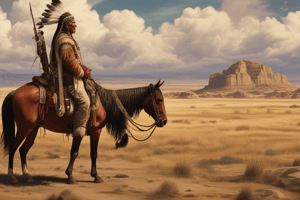Podcast
Questions and Answers
What is the approximate time period when indigenous peoples are believed to have migrated from Asia to the Americas?
What is the approximate time period when indigenous peoples are believed to have migrated from Asia to the Americas?
- 5,000-10,000 years ago
- 30,000-50,000 years ago
- 50,000-100,000 years ago
- 15,000-30,000 years ago (correct)
What was a significant impact of European colonization on indigenous populations?
What was a significant impact of European colonization on indigenous populations?
- The introduction of new agricultural practices
- Disease, warfare, displacement, and the introduction of European goods and animals (correct)
- The establishment of new educational systems
- The formation of new trade alliances
What was the primary goal of the Indian Reorganization Act of 1934?
What was the primary goal of the Indian Reorganization Act of 1934?
- To grant citizenship to all Native Americans
- To assimilate Native Americans into European-American culture
- To reverse assimilation policies and restore some self-governance (correct)
- To relocate Native American tribes to reservations
What was a common feature of religious beliefs among Native American tribes?
What was a common feature of religious beliefs among Native American tribes?
What was the primary purpose of the treaties between Native American tribes and European or American governments?
What was the primary purpose of the treaties between Native American tribes and European or American governments?
What was the significant event that took place in 1830?
What was the significant event that took place in 1830?
What type of societal structure was common among Native American tribes?
What type of societal structure was common among Native American tribes?
Which of the following was a key aspect of assimilation policies towards Native Americans?
Which of the following was a key aspect of assimilation policies towards Native Americans?
What is a significant issue currently facing Native American communities?
What is a significant issue currently facing Native American communities?
Who is a notable Native American writer?
Who is a notable Native American writer?
Flashcards are hidden until you start studying
Study Notes
Pre-Columbian Era
- Indigenous peoples migrated from Asia via the Bering Land Bridge around 15,000-30,000 years ago.
- Cultural regions developed in the Arctic, Subarctic, Northwest Coast, Plateau, Great Basin, Southwest, Plains, Northeast, and Southeast.
- Notable societies included the Ancestral Puebloans (Anasazi), Mississippian culture (Cahokia), Aztecs, Mayans, and Incas.
European Contact and Colonization
- Norse explorers arrived around 1000 AD, followed by Columbus in 1492, and subsequent Spanish, French, English, and Dutch explorers.
- Disease, warfare, displacement, and the introduction of European goods and animals dramatically affected indigenous populations.
Cultural Aspects
- Hundreds of languages exist, with many belonging to major families like Algonquian, Siouan, Athabaskan, and Iroquoian.
- Art and craft, such as pottery, beadwork, weaving, and carving, held spiritual and practical significance.
- Religious beliefs varied, but often included animism, shamanism, and a focus on harmony with nature.
- Social structures varied, with tribal organization, clan systems, and matrilineal or patrilineal descent.
Colonial and Early American Periods
- Numerous treaties were signed, but often broken by European and American governments.
- Major conflicts included King Philip's War, Pontiac's Rebellion, and the French and Indian War.
- Assimilation policies, such as mission systems, education in boarding schools, and the Dawes Act, aimed to erase Native American identity.
19th Century
- The Indian Removal Act (1830) forced relocation of tribes to lands west of the Mississippi River, resulting in the Trail of Tears.
- The reservation system confined Native Americans to undesirable lands.
- Resistance and warfare continued, with events like the Battle of Little Bighorn and the Apache Wars.
20th Century to Present
- The Indian Citizenship Act of 1924 granted U.S. citizenship to all Native Americans.
- Efforts to revive and preserve languages, traditions, and cultural practices have been ongoing.
- Modern issues include economic development, land rights, legal battles, healthcare disparities, and the fight against cultural appropriation.
Notable Figures and Leaders
- Historical figures include Sitting Bull, Crazy Horse, Geronimo, Pocahontas, and Sacagawea.
- Contemporary figures include activists like Wilma Mankiller, Vine Deloria Jr., and contemporary political leaders and artists.
Significant Legislation and Policies
- The Indian Reorganization Act (1934) aimed to reverse assimilation policies and restore self-governance.
- The Indian Civil Rights Act (1968) applied many constitutional rights to tribal governments.
- The American Indian Movement (AIM) was founded in 1968 to address issues of sovereignty, treaty rights, and police harassment.
Cultural Contributions
- Native American art and literature have influenced American art, literature, and film.
- Prominent writers include Sherman Alexie, Louise Erdrich, and N. Scott Momaday.
- Native foods like corn, beans, squash, potatoes, and tomatoes have contributed to global cuisine.
Current Challenges
- Ongoing legal battles over land, resources, and treaty rights continue.
- Economic and social issues, such as high rates of poverty, healthcare disparities, and substance abuse, persist.
Studying That Suits You
Use AI to generate personalized quizzes and flashcards to suit your learning preferences.




